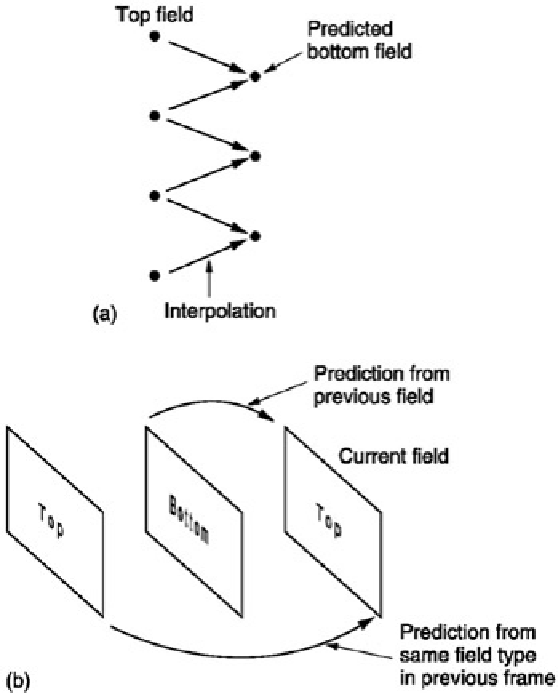Information Technology Reference
In-Depth Information
Figure 5.39:
(a) Each field contains half of the frame lines and so interpolation is needed to create values lying on
the sampling structure of the other field type. (b) Prediction can use data from the previous field or the one before
that.
If when using predictive coding from the other field type the vertical motion vector contains a half-pixel component,
then no interpolation is needed because the act of transferring pixels from one field to another results in such a
shift.
Figure 5.39(b) shows that a macroblock in a given
P
field-picture can be encoded using a vector which shifts data
from the previous field or from the field before that, irrespective of which frames these fields occupy. As noted
above, field-picture macroblocks come from an area of screen 32 lines high and this means that the vector density
is halved, resulting in larger prediction errors at the boundaries of moving objects.
As an option, field-pictures can restore the vector density by using 16 x 8 motion compensation where separate
vectors are used for the top and bottom halves of the macroblock. Frame-pictures can also use 16 x 8 motion
compensation in conjunction with field DCT. Whilst the 2 x 2 DCT block luminance structure of a macroblock can
easily be divided vertically in two, in 4:2:0 the same screen area is represented by only one chroma macroblock of
each component type. As it cannot be divided in half, this chroma is deemed to belong to the luminance DCT
blocks of the upper field. In 4:2:2 no such difficulty arises.
MPEG supports interlace simply because interlaced video exists in legacy systems and there is a requirement to
compress it. However, where the opportunity arises to define a new system, interlace should be avoided. Legacy
interlaced source material should be handled using a motion-compensated de-interlacer prior to compression in the
progressive domain.
5.16 MPEG-1 and MPEG-2 coders
Figure 5.40 shows a complete coder. The bidirectional coder outputs coefficients and vectors, and the quantizing
table in use. The vectors of
P
and
B
pictures and the DC coefficients of
I
pictures are differentially encoded in slices
and the remaining coefficients are RLC/VLC coded. The multiplexer assembles all these data into a single
bitstream called an elementary stream. The output of the encoder is a buffer which absorbs the variations in bit rate
between different picture types. The buffer output has a constant bit rate determined by the demand clock. This
comes from the transmission channel or storage device. If the bit rate is low, the buffer will tend to fill up, whereas if
it is high the buffer will tend to empty. The buffer content is used to control the severity of the requantizing in the
spatial coders. The more the buffer fills, the bigger the requantizing steps get.

